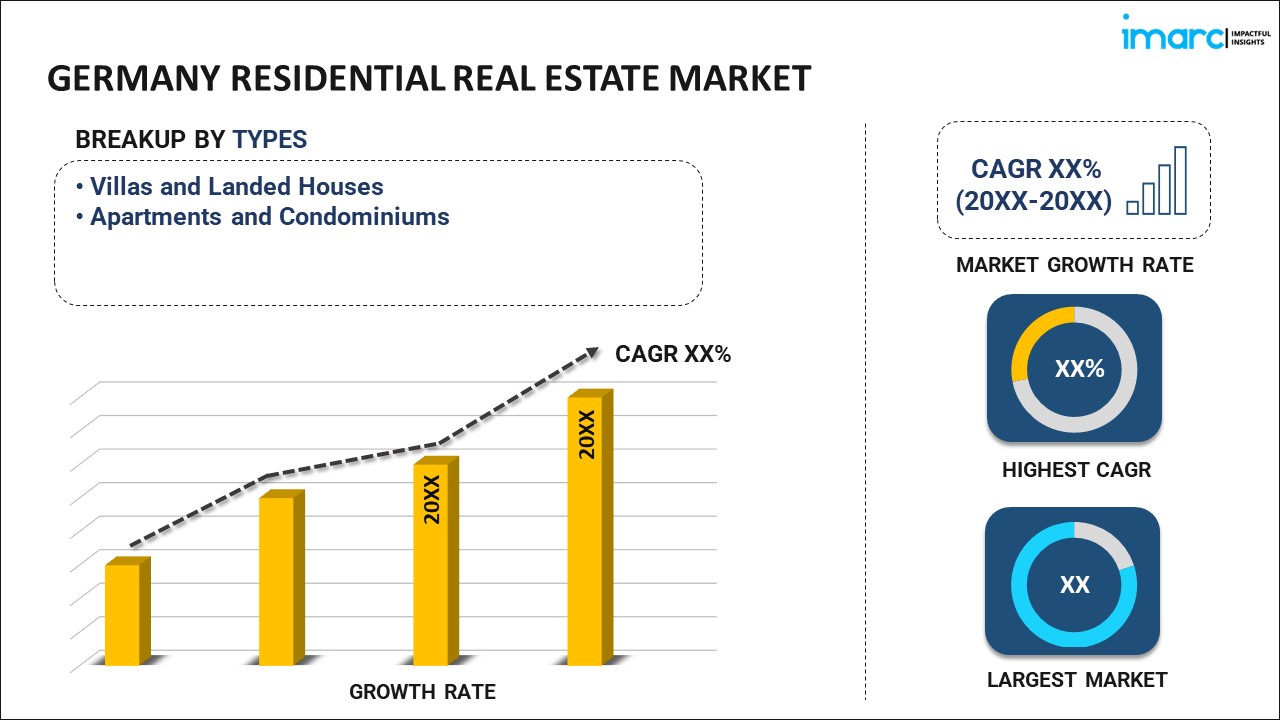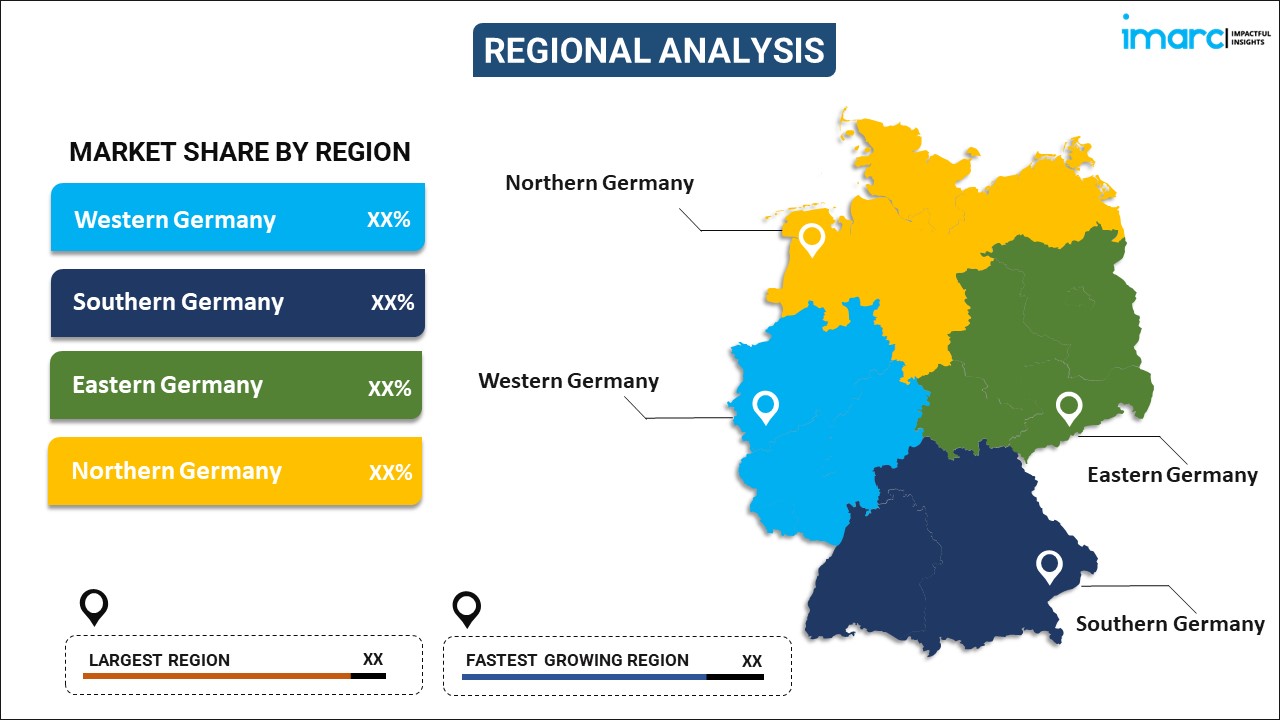
Germany Residential Real Estate Market Report by Type (Villas and Landed Houses, Apartments and Condominiums), and Region 2025-2033
Germany Residential Real Estate Market Overview:
The Germany residential real estate market size is projected to exhibit a growth rate (CAGR) of 4.22% during 2025-2033. Economic stability, rapid urbanization, low interest rates, population growth, increasing supportive government policies, and its appeal as a safe investment destination are collectively boosting housing demand and attracting both domestic and international investors, which is fostering the growth of the market.
|
Report Attribute
|
Key Statistics
|
|---|---|
|
Base Year
|
2024 |
|
Forecast Years
|
2025-2033
|
|
Historical Years
|
2019-2024
|
| Market Growth Rate (2025-2033) | 4.22% |
Germany Residential Real Estate Market Trends:
Rapid Urbanization
Rapid urbanization in Germany is acting as a major growth-inducing factor in the market. Major cities, such as Berlin, Munich, and Frankfurt, are experiencing increasing population inflows due to job opportunities, better living standards, and educational prospects. According to industry reports, Berlin's population grew by 0.7% in 2023 compared with the previous year. Accordingly, around 27,300 more residents lived in Berlin last year than in 2022. Those of 30 to under 35 years old form the numerically largest age group. With more than 940,000 foreign residents from around 170 nations and an average age of the population of 43 years old, Berlin is a cosmopolitan and young city.This urban migration fuels the demand for housing, leading to new residential developments and increased property values in urban centers.
Economic Stability
The strong and resilient economy of Germany provides a solid foundation for the real estate market. For instance, since Russia attacked Ukraine on 24th February 2022, millions of people have left the country. Roughly 1.1 million arrivals of people from Ukraine were recorded in Germany in 2022. This is reported by the Federal Statistical Office (Destatis) based on provisional results and an ad-hoc evolution of migration status. As Europe’s largest economy, Germany benefits from the robust industrial output, low unemployment rates, and a high standard of living this economic stability attracts both domestic and international investors seeking secure and profitable real estate investments. According to the industry report, with a gross domestic product (GDP) of €4.121 billion in 2023, Germany is the third-largest economy in the world after the United States and China, and thus also the largest economy in Europe. The country's consistent GDP growth and sound fiscal policies ensure a steady demand for residential properties, supporting market expansion.
Germany Residential Real Estate Market News:
- In May 2024, International law firm Bird & Bird advised ABG Real Estate Group on the re-financing of a large logistics and service center in Kerpen. The multimillion-euro re-financing was carried out by Münchener Hypothekenbank, one of the major European property banks. It specializes in the long-term financing of residential and commercial properties in Germany and other Western European countries.
- In October 2023, H.I.G. Capital, LLC (“H.I.G.”), a leading global alternative investment firm with $59 billion of capital under management, announced that an affiliate has invested in The Grounds Real Estate Development AG (the “Transaction”), a German real estate investment company listed on the Düsseldorf alternative stock exchange. Proceeds will be used to fund capital expenditures of The Grounds’ existing projects. The Grounds specializes in German residential properties in major metropolitan areas. As part of the Transaction, The Grounds’ major shareholders, currently holding a combined 73% stake in the company, have provided H.I.G. with the right to participate in future rights issuances.
Germany Residential Real Estate Market Segmentation:
IMARC Group provides an analysis of the key trends in each segment of the market, along with forecasts at the country level for 2025-2033. Our report has categorized the market based on type.
Type Insights:

- Villas and Landed Houses
- Apartments and Condominiums
The report has provided a detailed breakup and analysis of the market based on the type. This includes villas and landed houses and apartments and condominiums.
Regional Insights:

- Western Germany
- Southern Germany
- Eastern Germany
- Northern Germany
The report has also provided a comprehensive analysis of all the major regional markets, which include Western Germany, Southern Germany, Eastern Germany, and Northern Germany.
Competitive Landscape:
The market research report has also provided a comprehensive analysis of the competitive landscape in the market. Competitive analysis such as market structure, key player positioning, top winning strategies, competitive dashboard, and company evaluation quadrant has been covered in the report. Also, detailed profiles of all major companies have been provided.
Germany Residential Real Estate Market Report Coverage:
| Report Features | Details |
|---|---|
| Base Year of the Analysis | 2024 |
| Historical Period | 2019-2024 |
| Forecast Period | 2025-2033 |
| Units | Billion USD |
| Scope of the Report | Exploration of Historical Trends and Market Outlook, Industry Catalysts and Challenges, Segment-Wise Historical and Future Market Assessment:
|
| Types Covered | Villas and Landed Houses, Apartments and Condominiums |
| Regions Covered | Western Germany, Southern Germany, Eastern Germany, Northern Germany |
| Customization Scope | 10% Free Customization |
| Post-Sale Analyst Support | 10-12 Weeks |
| Delivery Format | PDF and Excel through Email (We can also provide the editable version of the report in PPT/Word format on special request) |
Key Questions Answered in This Report:
- How has the Germany residential real estate market performed so far and how will it perform in the coming years?
- What has been the impact of COVID-19 on the Germany residential real estate market?
- What is the breakup of the Germany residential real estate market on the basis of type?
- What are the various stages in the value chain of the Germany residential real estate market?
- What are the key driving factors and challenges in the Germany residential real estate?
- What is the structure of the Germany residential real estate market and who are the key players?
- What is the degree of competition in the Germany residential real estate market?
Key Benefits for Stakeholders:
- IMARC’s industry report offers a comprehensive quantitative analysis of various market segments, historical and current market trends, market forecasts, and dynamics of the Germany residential real estate market from 2019-2033.
- The research report provides the latest information on the market drivers, challenges, and opportunities in the Germany residential real estate market.
- Porter's five forces analysis assist stakeholders in assessing the impact of new entrants, competitive rivalry, supplier power, buyer power, and the threat of substitution. It helps stakeholders to analyze the level of competition within the Germany residential real estate industry and its attractiveness.
- Competitive landscape allows stakeholders to understand their competitive environment and provides an insight into the current positions of key players in the market.
Need more help?
- Speak to our experienced analysts for insights on the current market scenarios.
- Include additional segments and countries to customize the report as per your requirement.
- Gain an unparalleled competitive advantage in your domain by understanding how to utilize the report and positively impacting your operations and revenue.
- For further assistance, please connect with our analysts.
 Inquire Before Buying
Inquire Before Buying
 Speak to an Analyst
Speak to an Analyst
 Request Brochure
Request Brochure
 Request Customization
Request Customization




.webp)




.webp)












